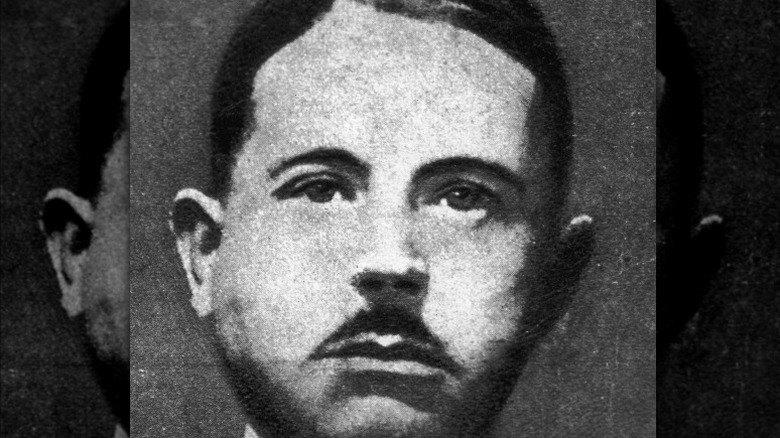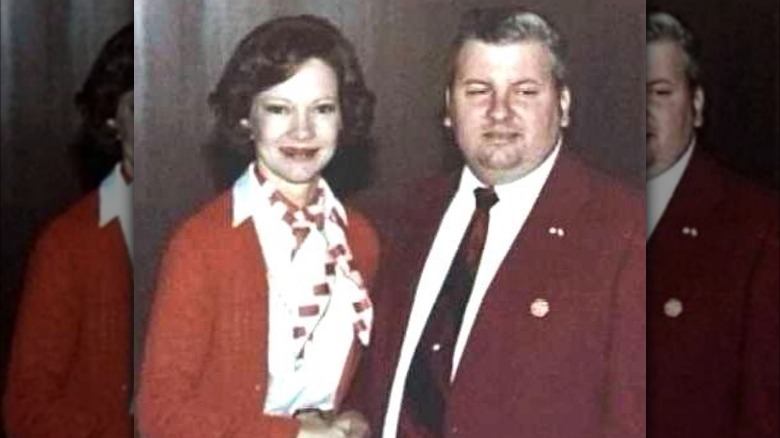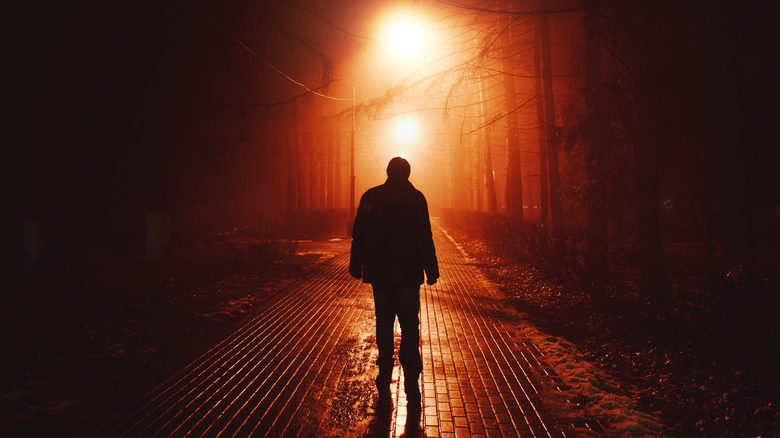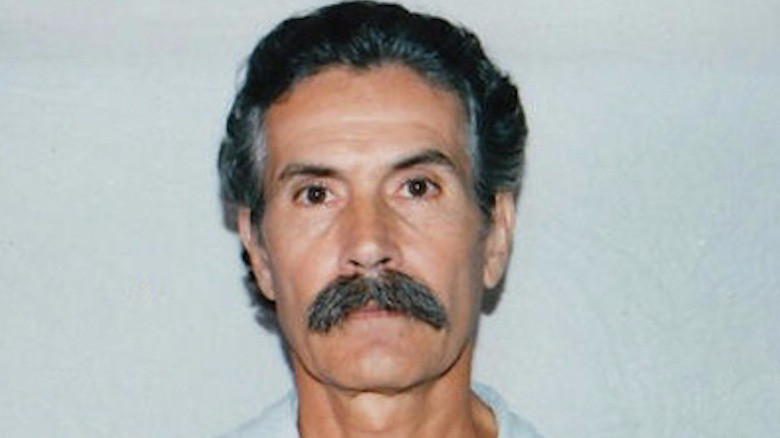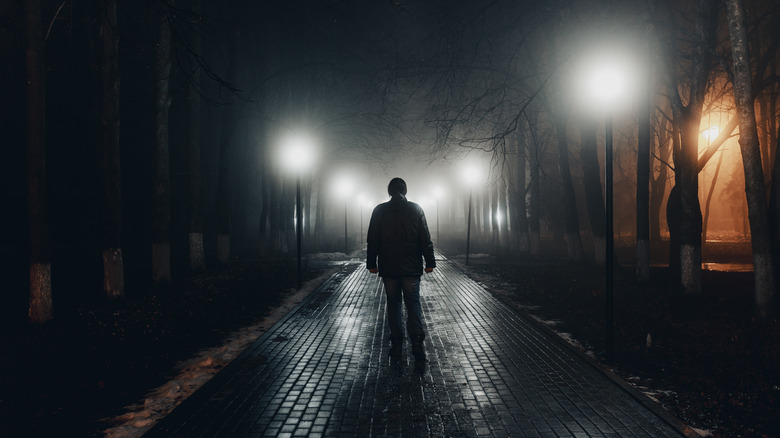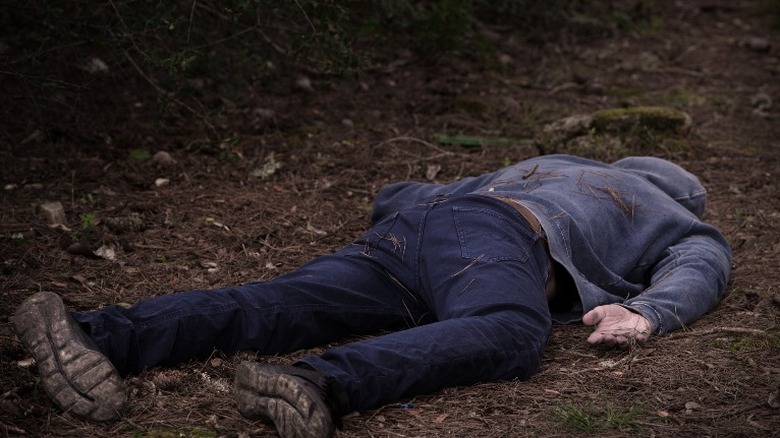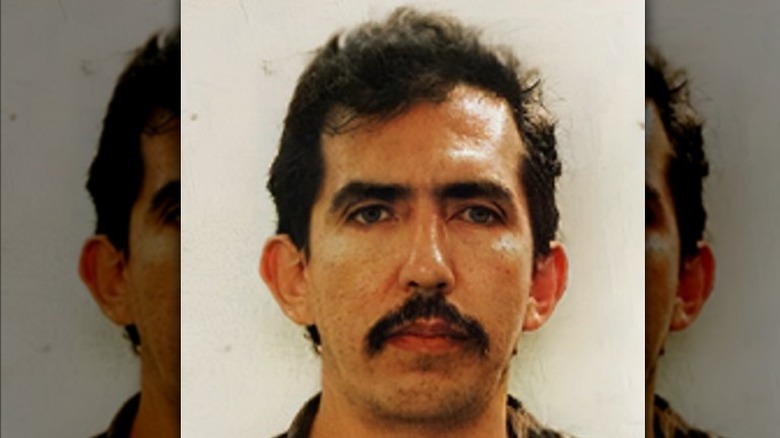The Most Dangerous Serial Killers Netflix Hasn't Done A Series On Yet
The streaming service Netflix is certainly no stranger to the genre of true crime. In 2015, it released the immensely popular docuseries "Making a Murderer," which went on to win 13 awards, including four Prime Time Emmys. In the years since the success of this series, Netflix has dominated the true crime category on streaming services. The sheer volume of docuseries and stand-alone documentaries the company makes available are too many to mention, but audiences still want more. According to the streaming service itself, Netflix believes that documentaries are "extraordinary because they remind us about the absurdity of everyday life and how real people and specific circumstances can make for the most interesting stories."
Netflix has also made available various streaming docuseries on what might be the darkest sub-genre of true crime: serial killers. The successes of 2019's "Conversations with a Killer: The Ted Bundy Tapes" and 2021's "Night Stalker: The Hunt for a Serial Killer" showed the world that even the most gruesome murderers have a story that audiences crave to know.
While there are multiple serial killer documentaries and docuseries that are exclusive to Netflix, there are countless others still left to be told. Let's take a look at the most dangerous serial killers yet to be featured.
Peter Kürten, the Vampire of Düsseldorf
Growing up poor and abused, Peter Kürten (pictured above) had a troubled childhood. As if the violence he was witnessing at home wasn't enough, All That's Interesting states that a young Kürten befriended a local dogcatcher, who then taught the boy how to torture and kill the dogs he caught.
Problems plagued Kürten throughout his teenage years, and he served time in prison on multiple occasions for burglary and arson. While locked away, he whiled away the time fantasizing about the various ways he could inflict cruelty on others. In 1913, Kürten was burglarizing a home when he discovered the homeowner's 9-year-old daughter in the house. He acted on all of the fantasies he had while in prison, and he raped and murdered her.
Thus began a long line of devious sexual and murderous acts by Kürten. His victim count was said to potentially be over 30, though he was only convicted of nine. Sentenced to death after a brief trial in 1931, Kürten went to face his maker on July 2. Biography reports that Kürten was a real creep, even up to the moment he was led to the guillotine. His last words were, "Tell me, after my head is chopped off, will I still be able to hear, at least for a moment, the sound of my own blood gushing from the stump of my neck? That would be the pleasure to end all pleasures."
John Wayne Gacy, the Killer Clown
There might not have been a more savage murderer of boys than John Wayne Gacy (pictured above, right). By the time the "Killer Clown" was brought to justice in 1978, Biography claims that Gacy had already murdered and disposed of at least 33 victims.
Married and living in suburban Chicago, Gacy managed to hide his murderous desires from friends and family. A successful contractor, Gacy used his business acumen and charisma to earn a solid reputation among the area business community as well as with local politicians. But Gacy was only able to keep his dark side hidden for so long. After six years of cruising for male victims, he was finally caught when the mother of 15-year-old Robert Piest reported him missing on December 11, 1978. It was reported to investigators that the teenager was supposed to meet Gacy about a construction job. When police questioned Gacy, Oxygen tells of how the investigators were so overtaken by the stench in his home that they were able to secure a warrant for a more thorough search. What they discovered underneath the main floor was horrifying.
Police saw that trenches had been dug in the crawlspace, in which they noticed decaying human remains. Gacy was immediately placed under arrest, and crime scene workers began to work in and around his property. All told, they found 29 bodies under Gacy's home. He was sentenced to death in 1980 and was executed in May 1994 (per A&E).
Bob Berdella, the Kansas City Butcher
Bob Berdella, the Kansas City Butcher, might have been viewed as an odd man by neighbors, but no one ever suspected that he was responsible for raping, torturing, and murdering seven men in 1980s Kansas City. HuffPost writes of how Berdella was a trusted figure who started a neighborhood watch program but mostly kept to himself. On the day before Easter in 1988, neighbors called the police after a naked man (wearing only a dog collar) leaped from Berdella's second-story bedroom window and ran screaming for someone to help him.
During an interview with police, the man told of how Berdella had lured him back to his home several days prior and had kept him tied to a bed. Over the course of several days, the man was brutally raped and tortured by Berdella before he was finally able to make a daring daylight escape. Acting with the authority of a warrant, investigators performed a thorough search of Berdella's home. There they discovered human bones, a basement torture chamber, and a logbook that chronicled all of the chilling details of how Berdella had tortured, raped, and killed six men in his home. According to Lessons from History, police excavated Berdella's yard and discovered the remains of multiple men.
In an effort to escape the death penalty, Berdella agreed to a plea bargain that spared his life. He died of a heart attack behind bars in 1992.
If you or anyone you know has been a victim of sexual assault, help is available. Visit the Rape, Abuse & Incest National Network website or contact RAINN's National Helpline at 1-800-656-HOPE (4673).
Rodney Alcala, the Dating Game Killer
It's not every day that a serial rapist and murderer appear on a game show, but that's what happened in September 1978 when Rodney Alcala (pictured above) was introduced as "Bachelor No. 1" on the hit show "The Dating Game." Biography tells us that Alcala was the winner of that episode, securing a date with contestant Cheryl Bradshaw. In a move that might have saved her life, Bradshaw rejected the date when the two met up face to face later, claiming that he was "acting really creepy."
Creepy might be an understatement. At the time of the show's taping, Alcala had already served time for multiple rapes (so much for background checks) and already had committed murder. He was arrested in 1979 and convicted for the murder of 12-year-old Robin Samsoe. Though convicted, he was able to secure the guilty verdict being overturned on prosecutorial misconduct. He was retried in 1986 and found guilty but had this verdict overturned on a technicality in 2001. Finally, in 2010, Alcala was tried and found guilty a third time. Using DNA evidence, prosecutors were able to link Alcala to the murders of multiple women.
Alcala was ultimately convicted of murdering nine women and sentenced to death. Because of the photos he took of dozens of unidentified women in what could have been homemade torture porn, it's thought that he might be responsible for more than 100 deaths.
Paul Bernardo and Karla Homolka, the Ken and Barbie Killers
Maybe there's nothing more shocking than when a seemingly normal couple turns out to be brutal killers. As exemplified by the case of the Ken and Barbie Killers, Paul Bernardo and Karla Homolka, good looks and wealthy backgrounds won't exclude you from being a vicious killer. According to All That's Interesting, the pair met when he was 23, and she was 17. They soon discovered that each shared the same sadistic sexual fantasies. With Homolka's blessing, Bernardo stalked and raped multiple women around Scarborough, Ontario, in the late 1980s. In several instances, Homolka was included as a willing participant in the crimes.
The Sun reports what might be the most vicious crime the couple committed. On Christmas Eve 1990, the couple drugged the eggnog of Homolka's 15-year-old sister. While unconscious, she was savagely raped by Bernardo. Much to the killers' surprise, Holmolka's sister began to vomit as the result of too much sedative. She choked on her vomit and died of asphyxiation. Not aware of the rape, authorities ruled the death an accident, leaving the murderous pair to continue their devious lifestyle. It wasn't until 1995 that they were arrested and tried for multiple rapes and murders, the result of Bernardo's DNA being a match for previous rape victims.
A plea deal resulted in a 12-year sentence for Holmolka, while Bernardo was sentenced to 25 years to life. He is believed to have killed four of his victims.
Joel Rifkin
"Seinfeld" fans might recall a classic episode in which Elaine is constantly embarrassed that her new boyfriend shares the name of a recently captured New York serial killer. His name is Joel Rifkin, and the name wasn't the result of a scriptwriter's imagination — Rifkin is a real-life serial killer, who Biography states murdered 17 women before police captured him in June 1993.
An intelligent man who had a troubled childhood, Rifkin was awkward and often the target of ridicule by schoolyard bullies. Perhaps this is why he never felt secure enough to develop normal relationships with women, instead relying on the company of prostitutes. Inspired by the 1972 Alfred Hitchcock film "Frenzy," Rifkin would continually fantasize about raping and strangling prostitutes to death. He was able to keep these urges in check until 1989, when he bludgeoned and strangled a young sex worker at his mother's home.
This unleashed the torrent of murderous intentions that Rifkin had been bottling up for nearly 20 years. Rifkin began picking up sex workers and strangling them, eventually disposing of their bodies in various places around Long Island. Rifkin was caught when police attempted to pull him over for a missing rear license plate. Knowing he had a three-day-old corpse of a sex worker in the trunk, he tried to evade police, leading them on a high-speed chase that ended when Rifkin drove into a utility pole. He was arrested, convicted, and sentenced to 25 years to life.
Andrei Chikatilo, Russia's Red Ripper
Born into a Ukrainian world where Stalin had forced a famine onto his people for fighting against collective farming, Andrei Chikatilo survived near starvation as a young child and bombing raids from Nazi invaders as a teenager. Biography discusses how a traumatic childhood, coupled with a medical condition called hydrocephalus, helped mold Chikatilo into the horrifying adult he would eventually become. His hydrocephalus, along with causing "water on the brain" from infancy on, led to urinary tract issues that resulted in bedwetting and impotence. Chikatilo was relentlessly bullied by his peers and faced rejection from women due to his sexual inadequacies.
Chikatilo took his first known life in 1978, a young girl whom he lured into a shed (via Murderpedia). Murdering her caused him to ejaculate, a cause and effect that would be a persistent factor in subsequent killings. He committed his second murder in 1981, leading to a string of additional murders that may have totaled as many as 56 by the time he was caught in November 1990. A patrolling police officer saw Chikatilo emerge from the woods onto a train platform, covered in mud. Suspicious of his behavior during questioning, the police began to watch Chikatilo closely. Soon after, he admitted to a police psychologist that he murdered over 50 people, ending a decade of terror that had eluded police. Chikatilo was executed in prison in 1994.
Belle Gunness, Hell's Belle
While most serial killers have perverse motivations for taking the lives of their prey, some are simply trying to make an easy buck. Belle Gunness fit this mold perfectly, using murder and life insurance scams to end the lives of multiple men and possibly the lives of her children (per Legends of America).
A Norwegian immigrant that eventually settled in the small town of La Porte, Indiana, Gunness and her husband opened a small shop in town. The shop wasn't performing well, and one day, it burned to the ground. Gunness and her husband collected the insurance, which may have sparked an idea in her warped mind. Two of her children, and later her husband, died under odd circumstances; life insurance was collected.
Gunness began putting ads in papers across the country, advertising herself as a widow with a farm who was seeking marriage. The men were lured in, took wedding vows, and then killed by Gunness soon after for insurance money. No one knows for sure how many she murdered, but some estimates place her death count as high as 40.
Police were called one day to the farm when a fire was reported. The bodies of three children and a headless woman were found in the rubble. But was it Gunness? No one knows for sure. Her handyman was arrested and found guilty of arson, but not murder. Multiple bodies were later found buried on the farm.
John Edward Robinson, the Internet Slave Master
John Edward Robinson was one of the first serial killers to gain notoriety by using the internet to find victims. "The Internet Slavemaster," as he was later dubbed, murdered as many as eight women, according to True Crime Magazine.
Before he was an unrepentant killer, Robinson was an Eagle Scout who grew into a man that was active in his community. He had a positive outward persona that he took careful time crafting, but behind the public face was a con artist and financial scammer. Robinson was eventually arrested for various financial crimes, including forgery and embezzlement, according to Murderpedia.
After serving time in prison from 1987 to 1993, Robinson discovered internet chat rooms. Using the name "Slavemaster," he began stalking BDSM chatrooms and was able to coax several victims to his home in Kansas, where they were tortured and killed. In 2000, Robinson was arrested at his home after two women "slaves" he was holding captive escaped and went to police with tales of torture. Police questioned Robinson and searched his home and storage unit. There, they found documents and other property belonging to women who had gone missing in the mid-1980s. They searched his farm in nearby Missouri and unearthed three barrels that contained female human remains.
Robinson was found guilty of three murders but later admitted to killing five others. He was sentenced to death in Kansas in 2003 and remains on death row.
Charles Ray Hatcher
Charles Ray Hatcher first saw death at around age 6 when he saw one of his older brothers get electrocuted. Born into a poor farming family in Mound City, Missouri, in 1929, Hatcher grew up in a life filled with poverty and abuse before growing into a young adult who was always on the wrong side of the law. Murderpedia writes how Hatcher was arrested and imprisoned multiple times for petty theft and stealing cars. But by 1959, Hatcher was beginning to get more violent. After a botched kidnapping of a 16-year-old boy in Saint Joseph, Missouri, Hatcher was sent to a Missouri Penitentiary. Hatcher was suspected of raping and stabbing a fellow inmate to death there in 1961. As this couldn't be proven, no charges were filed.
Hatcher spent time after prison drifting up and down the west coast, spending time in and out of prisons and mental hospitals after repeated attempted kidnappings and child sexual assaults. Deemed by medical officials to be a "mentally disordered sexual offender," Hatcher was confined in a mental hospital in California from 1972 until he was considered safe for release in 1978.
Hatcher drifted back to Saint Joseph, Missouri, that year and murdered a 4-year-old boy. The following, Hatcher came back through this community and murdered an 11-year-old girl. This time, he was caught. He was found guilty but admitted to 15 others that were later verified. Hatcher committed suicide in prison in 1984.
If you or anyone you know is having suicidal thoughts, please call the National Suicide Prevention Lifeline at 1-800-273-TALK (8255).
Luis Garavito, La Bestia
Luis Garavito (pictured above) might be the world's most notorious serial killer that you've never heard of. Given the nickname "La Bestia" ("The Beast") by the media in his country of Columbia, Garavito killed between 150 and 400 young boys between 1992 and 1999. All That's Interesting notes that the majority of his victims were between the ages of 6 and 16.
Columbia was ravaged by war and poverty when Garavito began his murder spree. The circumstances in his country led to thousands of boys being on the streets, homeless and hungry. Taking advantage of a desperate situation, Garavito preyed on the downtrodden youth he met, promising them friendship, a job, or another lie to gain their trust. Once that trust was granted, Garavito would rape and murder his victim. He repeated this over and over again until he was finally caught when police were investigating a mass grave reported to them. In this grave were the bodies of some of the boys Garavito had disposed of, along with a handwritten note his girlfriend had written to him. He discarded it there by mistake, and this slip-up led to a manhunt and his eventual arrest.
His official death count sits at 138, the number of murders he confessed to in court. He was sentenced to 1,853 years in prison, where he sits to this day.

